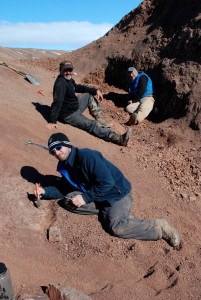By Mary Alice Hartsock and Gelsey Torres
Photographs by Ted Daeschler
Nunavut Territory, Arctic Canada.
Paleontologists.
Tiktaalik roseae fossils.
Jackhammers, shovels, a campsite.
Video cameras.
A prudent sound-recording technician with a suitcase full of survival gear—just in case his travel mates weren’t prepared for the elements.
A storyboard.
Did we lose you?
If we did, here’s the scoop. The team was filming a documentary on evolution featuring the discoverers of Tiktaalik roseae—that famous 375-million-year old fossil lobe-finned fish with many features only seen in tetrapods (limbed animals). Academy Curator of Vertebrate Paleontology and Drexel Associate Professor Ted Daeschler, along with Neil Shubin of the University of Chicago, the late Farish Jenkins of Harvard University, and other colleagues, discovered this incredible example of the evolutionary transition between finned and limbed animals in 2004, after two promising expeditions to the Nunavut site. Over the years, their discovery has attracted attention not only from the paleontology community, but also from documentary filmmakers, textbook publishers, teachers, and even medical professionals who believe Tiktaalik reveals important information about the history of life, including human evolution.

site where the team discovered Tiktaalik roseae in 2004.
Supported by a Howard Hughes Medical Institute initiative to fund educational programs on evolution, the documentary is based on Shubin’s acclaimed book, Your Inner Fish. The first of three episodes featured Shubin, Daeschler, and their colleagues Marcus Davis (Kennesaw State University) and Josh Miller (University of Cincinnati), as well as other evolutionary biologists.
The documentary premiered on PBS in April 2014 and is currently being used as a teaching tool in classrooms. You can watch clips of the documentary here. Daeschler’s participation in this documentary is yet another example of Academy scientists’ involvement in groundbreaking evolutionary research and their ability to communicate their discoveries to broad audiences.
So how do you film a documentary in the Arctic? In July 2013, a crew of four filmmakers joined Daeschler and his colleagues for their trip to the southern Ellesmere Island site where they discovered Tiktaalik roseae. Upon arrival, they set up camp, where on the first day they were hit by a minor snowstorm. Over the next 12 days, the team collected geological and fossil samples from the Tiktaalik site and the surrounding area. The film crew documented these activities and conducted interviews. The scientists jackhammered, shoveled rock, excavated fossils, and traversed the rocky landscape—mostly to fill in the blanks on the film crew’s storyboard.
Daeschler and his colleagues had explored the site thoroughly in the past, but they were eager to travel there again to search for missing pieces. They uncovered a rare piece of a Tiktaalik pelvis and some other Tiktaalik fragments, in addition to other Devonian fossils that help put the evolutionary events of that time into an ecological context.

The documentary is just one example of Tiktaalik’s profound impact on popular culture. We explore this topic in a special exhibit, A Farewell to Fins, on display in the museum through June 7. See the key specimen of Tiktaalik on display one last time before all the fossils travel back to Canada. Alongside the Late Devonian fossils are displays of cartoons, toys, books, a Canadian coin, a bottle of beer, and other cultural materials that use Tiktaalik’s likeness to refer to the point in time when a fish crawled out of the water and everything changed—forever. Buy tickets online, learn about the exhibit, or get details on our special Tiktaalik day on June 7.
Portions of this article originally appeared in the fall 2013 issue of our member magazine, Academy Frontiers.

